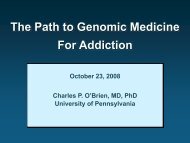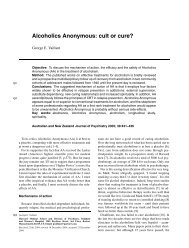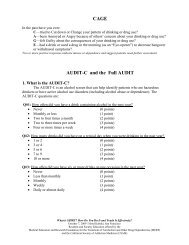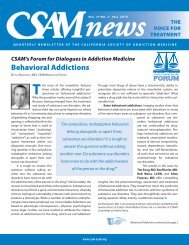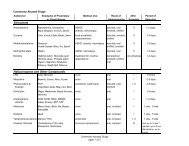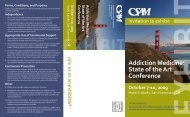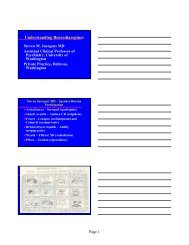SAN FRANCISCOMEDICINE - California Society of Addiction ...
SAN FRANCISCOMEDICINE - California Society of Addiction ...
SAN FRANCISCOMEDICINE - California Society of Addiction ...
You also want an ePaper? Increase the reach of your titles
YUMPU automatically turns print PDFs into web optimized ePapers that Google loves.
<strong>Addiction</strong> and Recovery<br />
Lessons in Urban Survival<br />
A Hustler Tells All<br />
Eisha Zaid<br />
“<br />
You can tell a lot by a person’s shoes.<br />
One look tells me if they are worth<br />
my efforts,” he said.<br />
My patient, a forty-something gentleman,<br />
was educating me about what he<br />
called “urban survival.”<br />
As a native <strong>of</strong> the Tenderloin, he relied<br />
on certain tactics to make ends meet. He<br />
was an expert-level street hustler. He was<br />
one <strong>of</strong> the successful ones and was capable<br />
<strong>of</strong> making a small fortune, probably<br />
enough to pay rent and live comfortably<br />
in a nice apartment somewhere outside<br />
the Tenderloin.<br />
Sadly, he burned through his earnings,<br />
spending massive amounts on one<br />
thing—crack cocaine.<br />
“Sometimes it feels like I am drowning<br />
just thinking about how much money<br />
I owe. But I want it [crack]. I need it. And I<br />
have to get it.”<br />
*****<br />
Cocaine is derived from the leaves <strong>of</strong><br />
Erythroxylon coca, a plant endemic to the<br />
Andes. In historical records, cocaine chewing<br />
was documented in South America<br />
as far back as 4,000 years ago, and for<br />
the last hundred years the plant has had<br />
medicinal uses because <strong>of</strong> its vasoconstricting<br />
effects. 1,2 Cocaine has multiple<br />
actions, including that <strong>of</strong> local anesthetic,<br />
CNS stimulant, appetite depressant, and<br />
vasoconstrictor. The effects are largely<br />
mediated through the inhibition <strong>of</strong> norepinephrine,<br />
dopamine, and serotonin<br />
uptake. 3<br />
Cocaine has become a popular street<br />
drug that can be sniffed, smoked, or injected<br />
intraveneously. As a recreational<br />
agent, cocaine has variable purity. The<br />
purest forms are white powder, while less<br />
pure forms are more yellow and have been<br />
cut with other drugs, such as lidocaine, caffeine,<br />
methamphetamine, ephedrine, and<br />
phencyclidine. 3 When cocaine is heated<br />
in an alkaline solution, it transforms into<br />
“crack,” which is sold in 100–150 mg<br />
“rocks” that can be smoked, while a “line”<br />
weighs 20–30 mg and is snorted. 3<br />
*****<br />
When I first met him, he was completely<br />
suicidal and was brought into the<br />
SFGH Psychiatric Emergency Services after<br />
being placed on a 5150 hold for being a<br />
danger to himself. After the initial evaluation,<br />
he was transferred to the inpatient<br />
psychiatric unit. At the time, he had no<br />
home and was completely out <strong>of</strong> money.<br />
He was a tall, thin, middle-aged man<br />
with a pinkish complexion. His hair was<br />
combed and slicked back. He wore a lime<br />
green collar shirt over blue hospital gown<br />
pants. His two front teeth protruded outward<br />
and had been eaten away and were<br />
stained brown.<br />
During our first meeting, it was as<br />
though everything was in slow motion.<br />
He moved aimlessly and spoke slowly<br />
when recounting the details <strong>of</strong> his suicide<br />
attempt. He had a flat affect, showing little<br />
facial expression. He appeared remorseful<br />
but remained deeply depressed. At<br />
times he would become teary-eyed when<br />
talking about being abused as a child and<br />
about his life in the Tenderloin. He was<br />
diagnosed with bipolar and polysubstance<br />
dependence.<br />
“When I get low, I get really low and go<br />
into these dark bouts <strong>of</strong> depression. There<br />
is no reason to live for me. No one gives a<br />
shit about me,” he said.<br />
His past addiction was alcohol; his<br />
current substance was cocaine. His heavy<br />
drug use required excessive amounts <strong>of</strong><br />
money, which he <strong>of</strong>ten did not have. Thus<br />
he borrowed from street lenders and still<br />
had to pay back his debt.<br />
The chronic use had left his life in<br />
shambles. He went from having it all—a<br />
condo, a girlfriend, and a stable job—to<br />
having nothing. He was living on the<br />
streets, had made many enemies, and<br />
relied on hustling to get his daily fix.<br />
He had been admitted to our inpatient<br />
unit numerous times before for suicide<br />
attempts and was in and out <strong>of</strong> residential<br />
treatment programs. He was followed by<br />
a case manager and was plugged into an<br />
extensive network <strong>of</strong> social support services,<br />
but he had difficulty committing to<br />
appointments and taking his medications.<br />
The hospital had become his security net,<br />
a revolving door for him.<br />
*****<br />
<strong>Addiction</strong> to drugs results from alterations<br />
in neurochemical processes, which<br />
ultimately lead to increased drug-seeking<br />
behavior. Cocaine, like many other drugs <strong>of</strong><br />
abuse, is highly addictive because it blocks<br />
dopamine uptake and results in increased<br />
dopamine levels in the nucleus accumbens.<br />
4 With respect to behavior, dopamine<br />
promotes reward-seeking behavior. 5<br />
Interestingly, with increased cocaine<br />
use, dopamine release results from exposure<br />
to certain stimuli, such as drug<br />
paraphernalia or environmental cues,<br />
findings that have been demonstrated in<br />
animal models. 6 This conditioned response<br />
explains the drug-seeking behavior observed<br />
in chronic users, who are driven<br />
to do whatever it takes to get their neurochemical<br />
fix.<br />
*****<br />
Over his two-week hospitalization, I<br />
Continued on the following page . . .<br />
www.sfms.org June 2010 San Francisco Medicine 33




